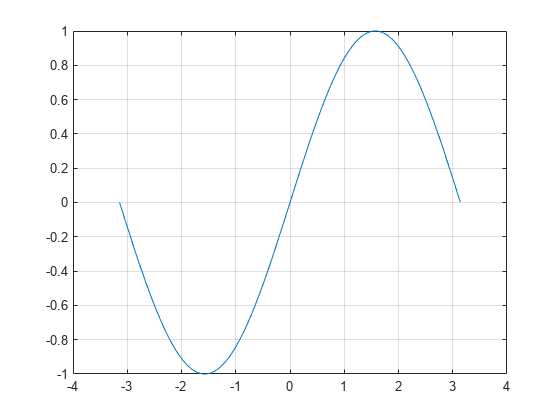sin - Sine of argument in radians - MATLAB (original) (raw)
Sine of argument in radians
Syntax
Description
[Y](#bt5p3vk-1-Y) = sin([X](#bt5p3vk-1-X)) returns the sine of the elements of X. The sin function operates element-wise on arrays. The function accepts both real and complex inputs.
- For real values of
X,sin(X)returns real values in the interval [-1, 1]. - For complex values of
X,sin(X)returns complex values.
Examples
Plot the sine function over the domain -π≤x≤π.
x = -pi:0.01:pi; plot(x,sin(x)), grid on

Calculate the sine of the complex angles in vector x.
x = [-i pi+ipi/2 -1+i4]; y = sin(x)
y = 1×3 complex
0.0000 - 1.1752i 0.0000 - 2.3013i -22.9791 +14.7448i
Input Arguments
Input angle in radians, specified as a scalar, vector, matrix, multidimensional array, table, or timetable.
Data Types: single | double | table | timetable
Complex Number Support: Yes
Output Arguments
Sine of input angle, returned as a real-valued or complex-valued scalar, vector, matrix, multidimensional array, table, or timetable.
More About
The sine of an angle, α, defined with reference to a right triangle is

The sine of a complex argument, α, is
Tips
- To compute
sin(X*pi)accurately, without usingpias a floating-point approximation of π, you can use the sinpi function instead. For example,sinpi(n)is exactly zero for integersnandsinpi(m/2)is +1 or –1 for odd integersm.
Extended Capabilities
Thesin function fully supports tall arrays. For more information, see Tall Arrays.
The sin function fully supports GPU arrays. To run the function on a GPU, specify the input data as a gpuArray (Parallel Computing Toolbox). For more information, see Run MATLAB Functions on a GPU (Parallel Computing Toolbox).
Version History
Introduced before R2006a
The sin function can calculate on all variables within a table or timetable without indexing to access those variables. All variables must have data types that support the calculation. For more information, see Direct Calculations on Tables and Timetables.